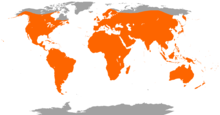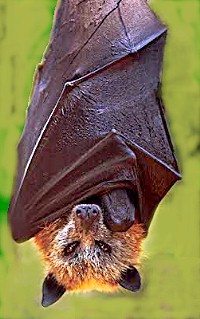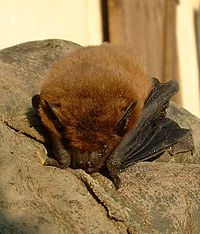From Wikipedia, the free encyclopedia
| Bat Temporal range: 52–0Ma Early Eocene – Recent |
|
|---|---|
 |
|
| Townsend's big-eared bat, Corynorhinus townsendii | |
| Scientific classification | |
| Kingdom: | Animalia |
| Phylum: | Chordata |
| Class: | Mammalia |
| Infraclass: | Eutheria |
| Superorder: | Laurasiatheria[1] |
| Order: | Chiroptera Blumenbach, 1779 |
| Suborders | |
| See article | |
 |
|
| Worldwide distribution of bat species | |
Bats represent about 20% of all classified mammal species worldwide, with about 1,240 bat species divided into two suborders: the less specialized and largely fruit-eating megabats, or flying foxes, and the highly specialized and echolocating microbats.[5] About 70% of bats are insectivores. Most of the rest are frugivores, or fruit eaters. A few species, such as the fish-eating bat, feed from animals other than insects, with the vampire bats being hematophagous.
Bats are present throughout most of the world, performing vital ecological roles of pollinating flowers and dispersing fruit seeds. Many tropical plant species depend entirely on bats for the distribution of their seeds. Bats are important, as they consume insect pests, reducing the need for pesticides. The smallest bat is the Kitti's hog-nosed bat, measuring 29–34 mm (1.14–1.34 in) in length, 15 cm (5.91 in) across the wings and 2–2.6 g (0.07–0.09 oz) in mass.[6][7] It is also arguably the smallest extant species of mammal, with the Etruscan shrew being the other contender.[8] The largest species of bat are a few species of Pteropus and the giant golden-crowned flying fox with a weight up to 1.6 kg (4 lb) and wingspan up to 1.7 m (5 ft 7 in).[9]
Classification and evolution
The two traditionally recognized suborders of bats are:
- Megachiroptera (megabats)
- Microchiroptera (microbats/echolocating bats)
- Microbats use echolocation; with the exception of Rousettus and its relatives, megabats do not.
- Microbats lack the claw at the second toe of the forelimb.
- The ears of microbats do not close to form a ring; the edges are separated from each other at the base of the ear.
- Microbats lack underfur; they are either naked or have guard hairs.
The phylogenetic relationships of the different groups of bats have been the subject of much debate. The traditional subdivision between Megachiroptera and Microchiroptera reflects the view that these groups of bats have evolved independently of each other for a long time, from a common ancestor already capable of flight. This hypothesis recognized differences between microbats and megabats and acknowledged that flight has only evolved once in mammals. Most molecular biological evidence supports the view that bats form a single or monophyletic group.[14]
Researchers have proposed alternative views of chiropteran phylogeny and classification, but more research is needed.
In the 1980s, a hypothesis based on morphological evidence was offered that stated the Megachiroptera evolved flight separately from the Microchiroptera. The so-called flying primates theory proposes that, when adaptations to flight are removed, the Megachiroptera are allied to primates by anatomical features not shared with Microchiroptera. One example is that the brains of megabats show a number of advanced characteristics that link them to primates. Although recent genetic studies strongly support the monophyly of bats,[15] debate continues as to the meaning of available genetic and morphological evidence.[16]
Genetic evidence indicates megabats originated during the early Eocene and should be placed within the four major lines of microbats.
Consequently, two new suborders based on molecular data have been proposed. The new suborder Yinpterochiroptera includes the Pteropodidae or megabat family, as well as the Rhinolophidae, Hipposideridae, Craseonycteridae, Megadermatidae, and Rhinopomatidae families[17] The new suborder Yangochiroptera includes all the remaining families of bats (all of which use laryngeal echolocation). These two new suborders are strongly supported by statistical tests. Teeling (2005) found 100% bootstrap support in all maximum likelihood analyses for the division of Chiroptera into these two modified suborders. This conclusion is further supported by a 15-base-pair deletion in BRCA1 and a seven-base-pair deletion in PLCB4 present in all Yangochiroptera and absent in all Yinpterochiroptera.[17] The chiropteran phylogeny based on molecular evidence is controversial because microbat paraphyly implies one of two seemingly unlikely hypotheses occurred. The first suggests laryngeal echolocation evolved twice in Chiroptera, once in Yangochiroptera and once in the rhinolophoids.[18][19] The second proposes laryngeal echolocation had a single origin in Chiroptera, was subsequently lost in the family Pteropodidae (all megabats), and later evolved as a system of tongue-clicking in the genus Rousettus.[20]
In addition to Yinpterochiroptera and Yangochiroptera, the names Pteropodiformes and Vespertilioniformes have also been proposed for these suborders.[23][24] Under this new proposed nomenclature, the suborder Pteropodiformes includes all extant bat families more closely related to the genus Pteropus than the genus Vespertilio, while the suborder Vespertilioniformes includes all extant bat families more closely related to the genus Vespertilio than to the genus Pteropus.
Little fossil evidence is available to help map the evolution of bats, since their small, delicate skeletons do not fossilize very well. However, a Late Cretaceous tooth from South America resembles that of an early microchiropteran bat. Most of the oldest known, definitely identified bat fossils were already very similar to modern microbats. These fossils, Icaronycteris, Archaeonycteris, Palaeochiropteryx and Hassianycteris, are from the early Eocene period, 52.5 million years ago.[14] Archaeopteropus, formerly classified as the earliest known megachiropteran, is now classified as a microchiropteran.
Bats were formerly grouped in the superorder Archonta along with the treeshrews (Scandentia), colugos (Dermoptera), and the primates, because of the apparent similarities between Megachiroptera and such mammals. Genetic studies have now placed bats in the superorder Laurasiatheria, along with carnivorans, pangolins, odd-toed ungulates, even-toed ungulates, and cetaceans.[1]
| Laurasiatheria |
|
||||||||||||||||||||||||||||||
- Order Chiroptera
- Suborder Megachiroptera (megabats)
- Suborder Microchiroptera (microbats)
- Superfamily Emballonuroidea
- Emballonuridae (Sac-winged or sheath-tailed bats)
- Superfamily Molossoidea
- Superfamily Nataloidea
- Superfamily Noctilionoidea
- Mormoopidae (Ghost-faced or moustached bats)
- Mystacinidae (New Zealand short-tailed bats)
- Noctilionidae (Bulldog bats or fisherman bats)
- Phyllostomidae (Leaf-nosed bats)
- Superfamily Rhinolophoidea
- Megadermatidae (False vampires)
- Nycteridae (Hollow-faced or slit-faced bats)
- Rhinolophidae (Horseshoe bats)
- Hipposideridae (Old World leaf-nosed bats)
- Superfamily Rhinopomatoidea
- Craseonycteridae (Bumblebee bat or Kitti's hog-nosed bat)
- Rhinopomatidae (Mouse-tailed bats)
- Superfamily Vespertilionoidea
- Vespertilionidae (Vesper bats or evening bats)
- Antrozoidae (Pallid bat and Van Gelder's bat)
- Superfamily Emballonuroidea
Fossil bats
Fossilized remains of bats are few, as they are terrestrial and light-boned. Only an estimated 12% of the bat fossil record is complete at the genus level.[25] Fossil remains of an Eocene bat, Icaronycteris, were found in 1960. Another Eocene bat, Onychonycteris finneyi, was found in the 52-million-year-old Green River Formation in Wyoming, United States, in 2003.[26][27] This intermediate fossil has helped to resolve a long-standing disagreement regarding whether flight or echolocation developed first in bats. It had characteristics indicating it could fly, yet the well-preserved skeleton showed the cochlea of the inner ear lacked development needed to support the greater hearing abilities used by modern echolocating bats. This provided evidence flight in bats developed well before echolocation. The team that found the remains of O. finneyi recognized it lacked ear and throat features present not only in echolocating bats today, but also in other known prehistoric species.The appearance and flight movement of bats 52.5 million years ago were different from those of bats today. Onychonycteris had claws on all five of its fingers, whereas modern bats have at most two claws appearing on two digits of each hand. It also had longer hind legs and shorter forearms, similar to climbing mammals that hang under branches such as sloths and gibbons. This palm-sized bat had short, broad wings, suggesting it could not fly as fast or as far as later bat species. Instead of flapping its wings continuously while flying, Onychonycteris likely alternated between flaps and glides while in the air. Such physical characteristics suggest this bat did not fly as much as modern bats do, rather flying from tree to tree and spending most of its waking day climbing or hanging on the branches of trees.[28]
Habitats
Flight has enabled bats to become one of the most widely distributed groups of mammals.[29] Apart from the Arctic, the Antarctic and a few isolated oceanic islands, bats exist all over the world.[30] Bats are found in almost every habitat available on Earth. Different species select different habitats during different seasons, ranging from seasides to mountains and even deserts, but bat habitats have two basic requirements: roosts, where they spend the day or hibernate, and places for foraging. Bat roosts can be found in hollows, crevices, foliage, and even human-made structures, and include "tents" the bats construct by biting leaves.[31]The United States is home to an estimated 45 to 48 species of bats.[32][33] The three most common species are Myotis lucifugus (little brown bat), Eptesicus fuscus (big brown bat), and Tadarida brasiliensis (Mexican free-tailed bat). The little and the big brown bats are common throughout the northern two-thirds of the country, while the Mexican free-tailed bat is the most common species in the southwest.[34]




No comments:
Post a Comment